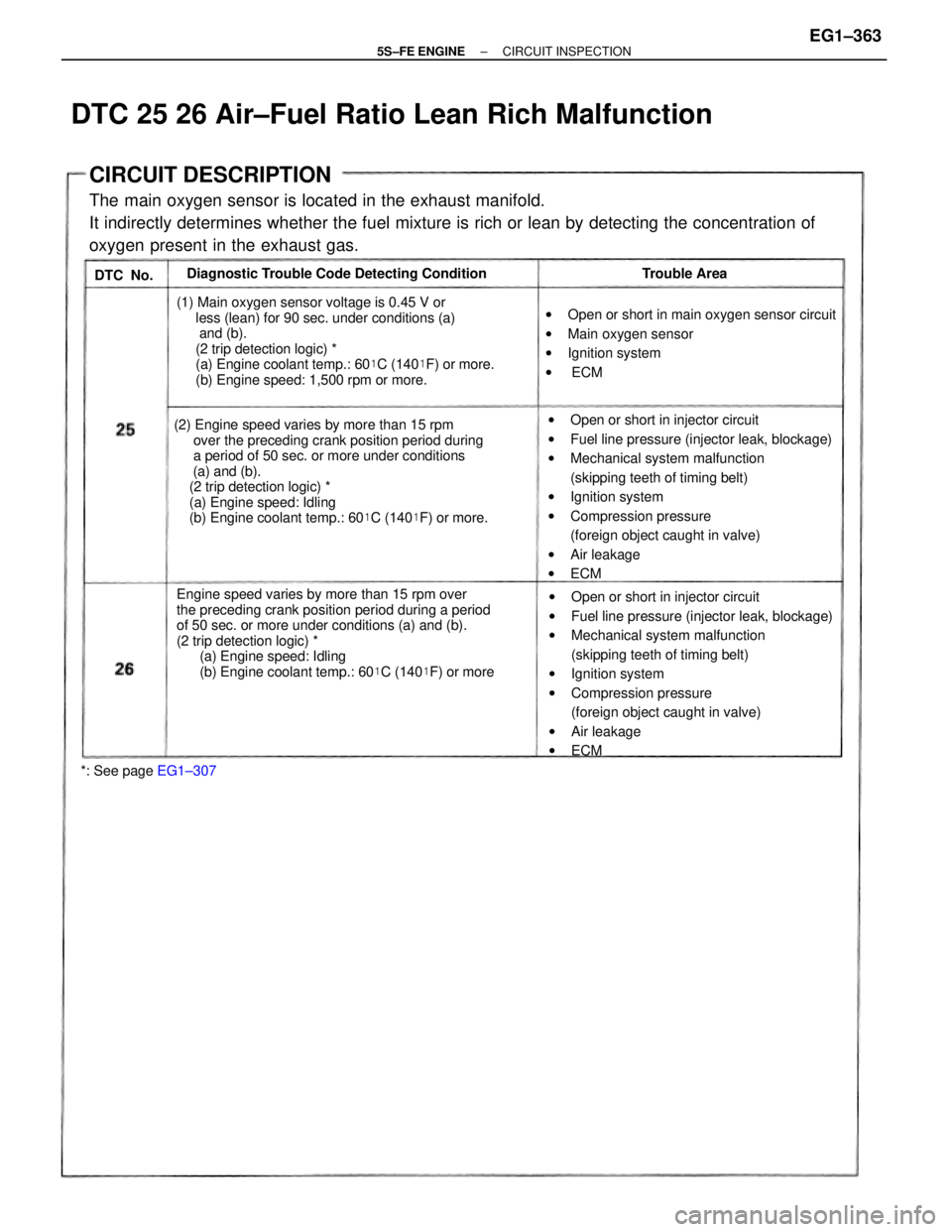Page 413 of 4770

CIRCUIT DESCRIPTION
The main oxygen sensor is located in the exhaust manifold.
It indirectly determines whether the fuel mixture is rich or lean by detecting the concentration of
oxygen present in the exhaust gas.
Engine speed varies by more than 15 rpm over
the preceding crank position period during a period
of 50 sec. or more under conditions (a) and (b).
(2 trip detection logic) *
(a) Engine speed: Idling
(b) Engine coolant temp.: 60�C (140�F) or more (2) Engine speed varies by more than 15 rpm
over the preceding crank position period during
a period of 50 sec. or more under conditions
(a) and (b).
(2 trip detection logic) *
(a) Engine speed: Idling
(b) Engine coolant temp.: 60�C (140�F) or more.wOpen or short in injector circuit
wFuel line pressure (injector leak, blockage)
wMechanical system malfunction
(skipping teeth of timing belt)
wIgnition system
wCompression pressure
(foreign object caught in valve)
wAir leakage
wECM
wOpen or short in injector circuit
wFuel line pressure (injector leak, blockage)
wMechanical system malfunction
(skipping teeth of timing belt)
wIgnition system
wCompression pressure
(foreign object caught in valve)
wAir leakage
wECM (1) Main oxygen sensor voltage is 0.45 V or
less (lean) for 90 sec. under conditions (a)
and (b).
(2 trip detection logic) *
(a) Engine coolant temp.: 60�C (140�F) or more.
(b) Engine speed: 1,500 rpm or more.wOpen or short in main oxygen sensor circuit
wMain oxygen sensor
wIgnition system
w ECM Diagnostic Trouble Code Detecting Condition
*: See page EG1±307Trouble Area
DTC 25 26 Air±Fuel Ratio Lean Rich Malfunction
DTC No.
± 5S±FE ENGINECIRCUIT INSPECTIONEG1±363
Page 498 of 4770
17
INTERIOR
� SEAT BELTS
1. Front Seat Belts
�3±point ELR (Emergency Locking Retractor)
seat blets are provided. The passenger seat is
additionally provided with an ALR
(Auto±Locking Retractor) mechanism.
�An adjustable shoulder belt anchor is provided on
all models.
2. Rear Seat Belts
In addition to those on the outer seats, a 3±point ELR with ALR seat blet is provided for the center seat.
Page 509 of 4770

30
ENGINE
5S±FE ENGINE
� DESCRIPTION
The 5S±FE engine has improved the torque in the low±to±mid±speed range through improvements made for the intake
and exhaust systems and the combustion chamber. In addition, its exhaust emissions have been reduced through the
improvements made for the exhaust system and the engine control system.
� ENGINE SPECIFICATIONS AND PERFORMANCE CURVE
5S±FE EngineNewPreviousItemNewPrevious
No. of Cyls. & Arrangement6±Cylinder, In±Lineu
Valve Mechanisms16±Valve DOHC,
Belt & Gear Driveu
Combustion ChamberPentroof Typeu
ManifoldsCross±Flowu
Fuel SystemSFIu
Displacement cm3(cu. in.)2164 (132.0)u
Bore x Stroke mm (in.)87.0 x 91.0 (3.43 x 3.58)u
Compression Ratio9.5 : 1u
Max. Output [SAE±NET]
99 kW @ 5200 rpm
(133 HP @ 5200 rpm)
97 kW @ 5200 rpm*
(130 HP @ 5200 rpm)*
93 kW @ 5400 rpm
(125 HP @ 5400 rpm)
Max. Output [SAE±NET]
199 N.m @ 4400 rpm
(147 ft
.lbf @ 4400 rpm)
197 N
.m @ 4400 rpm*
(145 HP @ 4400 rpm)*
197 N.m @ 4400 rpm
(145 ft
.lbf @ 4400 rpm)
IntakeOpen3o BTDCu
Valve Timing
IntakeClose43o ABDCuValve Timing
ExhaustOpen45o
BBDCuExhaustClose3o
ATDCu
Fuel Octane Number RON91u
Oil GradeAPI SH EC±II, ILDAC or Betteru
*: California Specification Model
Page 523 of 4770

44ENGINEÐ1MZ±FE ENGINE
1MZ±FE ENGINE
� DESCRIPTION
The 1MZ±FE engine has achieved a reduction in exhaust emissions through the adoption of the fuel returnless system
and the changes made onto the EGR control system.
� ENGINE SPECIFICATIONS AND PERFORMANCE CURVE
1MZ±FE EngineNewPreviousItemNewPrevious
No. of Cyls. & Arrangement6±Cylinder, V Typeu
Valve Mechanisms24±Valve DOHC,
Belt & Gear Driveu
Combustion ChamberPentroof Typeu
ManifoldsCross±Flowu
Fuel SystemsSFIu
Displacement cm3(cu. in.)2995 (182.7)u
Bore x Stroke mm (in.)87.5 x 83.0 (3.44 x 3.27)u
Compression Ratio10.5 : 1u
Max. Output {SAE_NET]145 kW @ 5200 rpm
(194 HP @ 5200 rpm)140 kW @ 5200 rpm
(188 HP @ 5200 rpm)
Max. Output {SAE_NET]283 N.m @ 4400 rpm
(209 ft
.lbf @ 4400 rpm)
275 N.m @ 4400 rpm
(203 ft
.lbf @ 4400 rpm)
IntakeOpen4o BTDCu
Valve Timing
IntakeClose44o ABDCuValve Timing
ExhaustOpen46oBBDCuExhaustClose2o
ATDCu
Fuel Octane Number RON91 OR Higheru
Oil GradeAPI SH EC±II, ILDAC or Betteru
Premium unleaded gasoline (96RON) is used for the above specifications.
Page 568 of 4770
93 BODYÐLIGHTWEIGHT AND HIGHLY RIGID BODY
Impact Absorbing Structure for Side Collision
Impact energy of a side collision directed to the cabin area is dispersed throughout the body via pillar reinforcements,
side impact protection beams, floor cross members, etc. This dispersion of energy keeps the energy directed to the
cabin to a minimum level. In additon, the body is made highly rigid through the cabin space. And, in order to make
the door more energy absorbent, a closed cross section configuration is provided at the belt line area of the front and
rear doors.
Also, a soft upper interior construction has been adopted. With this type of constrution, if the occupant's head collides
against the roof side rail in reaction to a collision, the inner panel of the roof side rail collapses to reduct the impact.
�Impact Absorbing Structure for Side Collision�
�Soft Upper Interior Structure�
Page 574 of 4770
99 BODYÐENHANCEMENT OF PRODUCT APPEAL
� CRS (CHILD RESTRAINT SYSTEM)
�The CRS is enclosed in the seatback for the right rear seat in order to provide a comfortable and safe restraint seating
for a child in the 22 to 60 lbs. (10.0 to 27.2 kg) range. When the CRS is not being used, it can be retracted to perform
the normal seating function of the rear seat.
�The CRS uses a 5±point seat belt.
Page 581 of 4770

106BODY ELECTRICALÐACCESSORIES
SystemOutline
SRS Airbag
The SRS (Supplemental Restraint System) airbag is provided for the driver
and front passenger. The SRS airbag has been designed to lessen the shock to
the head and chest of the driver and front passenger in the event of a frontal
impact collision as a supplement to the seat belt.
A 1±sensor type airbag system is used in which the detection of decelera-
tion during a collision as well as control of the airbag system is accom-
plished by the airbag sensor assembly.
The basic construction and operation are the same as in the '96 Avalon.
However, the inflator for front passsenger and airbag sensor assembly have
been changed.
For details, see page 111.
Cruise Control System
Once it has been set at a desired vehicle speed, this system automatically
adjusts the engine throttle position to maintain the vehicle speed at the de-
sired speed without operating the acceleration pedal.
The basic construction and operation are the same as in the previous model.
However, in the new model, a new type acutator has been adopted. Also, the
functions of the cruise control ECU has been changed. For details, see page
116.
Moon Roof
The moon roof is a tilt±up and sliding type the same as in the previous mod-
el. This system includes ªkey±off operationº, which is the same as with the
power window system. The new model offers an additional ªone±touch slide
openº function which enables the moon roof to fully open when the slide
switch is pressed toward the opening side for a few seconds.
Electrical Remote Control Mirror
The electrical remote control mirrors used in the previous model are also
used in the new model. Also, the internal heater to remove water drops from
the mirror surface is provided.
Key Reminder System
When the driver's door is opened with the ignition key in the ACC or LOCK
position, this system sounds a buzzer to warn the driver that the ignition key
has not been removed.
The basic construction and operation are the same as in the previous model.
Page 586 of 4770

111 BODY ELECTRICALÐACCESSORIES
� SRS AIRBAG
1. General
�The SRS (Supplemental Restraint System) airbag is designed to help lessening the shock to the driver and front
passenger as a supplement to the seat belt. In a collision, the aribag sensor detects the shock and if the front±to±rear
shock is greater than a specified value, the airbags stored in the steering wheel pad for the driver and above the glove
box for the front passenger inflate instantly to help reducing the likelihood of the driver's or front passenger's head
and chest directly hitting the steering wheel or instrument panel.
�As in the '96 Avalon, a 1±sensor type airbag system is used, in chich the detection of deceleration during a collision
is accomplished by the airbag sensor enclosed in the airbag snesor assembly.
�The airbag system is controlled by the airbag sensor assembly. It has a self±diagnosis function. When it detects a
system malfunction, it lights up the SRS warning light on the combination meter to alert the driver.
The basic construction and operation are the same as in teh '96 Avalon. However, 2 types of the inflator for front
passenger have been adopted in the new Camry: TRW made and Morton made. Also, the construction of airbag sensor
assembly has been changed.
�System Diagram�
The activation processes of the SRS airbag is as illustrated below.